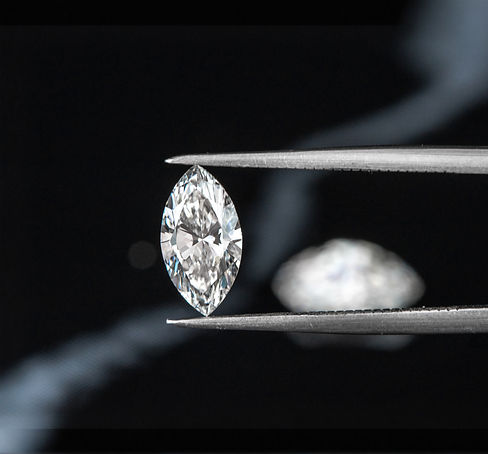
The 4Cs
Defining characteristics of every diamond.
IGI and GIA’s diamond grading provides the consistent and unbiased results that the global diamond industry and diamond customers trust. Without strict standards, the characteristics, quality and value of a diamond would be left open to interpretation. Choosing a diamond may be a matter of preference, but evaluating a diamond is a matter of precision.

CUT
Cut determines how gracefully a diamond’s facets capture and reflect light.
A diamond’s cut refers to the balance of proportion, polish, and symmetry it possesses. Cut is the difference between a round brilliant diamond and a step cut emerald diamond. But cut is different to diamond shape, which dictates the overall silhouette of the stone.
Cut is more about what's on the inside.
The way a diamond’s facets are cut will affect its light performance or, in other words, how sparkly, bright, and reflective it is. Diamond quality really depends on cut. In fact, a diamond’s cut is arguably the most important category when determining the stone’s value.
The facets of a diamond bounce, scatter, and reflect light to create myriad effects. Each facet pattern creates something special, unique, and a little bit magical. That’s why jewellers have to be part artist, part mathematician, and part spellbinder using precisely cut angles to create dazzling results.
A well-cut stone will reflect light straight up through its crown (its upper facets), displaying that characteristic, scintillating appearance diamonds are valued for.
If a diamond’s cut is too deep, shallow, or out-of-proportion, light can leak out of the pavilion facets (lower facets) of the stone, reducing its sparkle and making it appear dull.
A diamond’s cut is graded on a ten-point scale ranging from Poor to Ideal.
COLOUR
Colour refers to the natural presence or absence of visible hue within a diamond.
The clearer the stone, the higher its value; yellow or brown tints lower its grade and brilliance.These subtle hues are caused by trace elements present during the diamond’s formation. While a hint of colour can add character, it can also reduce light performance, making the stone appear darker or less vibrant.
In contrast, colourless diamonds allow light to pass freely, enhancing fire and sparkle. Lab-grown diamonds typically fare better in this category. Grown under controlled conditions, they are less likely to contain the mineral impurities that cause colour in mined stones.
All diamonds are graded using the GIA scale, from D (colourless) to Z (light yellow or brown). While mined diamonds can span the full range, lab-grown diamonds tend to fall between D and J, offering exceptional clarity and value.


CLARITY
Clarity measures how pure a diamond is based on the presence of internal or surface imperfections, known as inclusions.
As diamonds form, it’s natural for microscopic particles to become trapped within them. While most flaws are only visible under 10x magnification, they influence both the stone’s clarity grade and value. A diamond with fewer inclusions commands a higher price.
These tiny imperfections also make each diamond one of a kind, adding subtle character and charm.
Clarity is graded on an eleven-point scale, from Flawless (FL) to Included (I3). At Cherish & Co Bespoke Diamonds, we select only diamonds graded VVS1–2 or higher, ensuring remarkable brilliance and a clean, captivating sparkle.
CARAT
Carat (ct) is the unit used to measure a diamond’s weight. But not always its visible size.
Different cuts distribute weight uniquely, so two diamonds of equal carat may appear very different in dimensions. That’s why gem size is also measured by length and width in millimetres.
Generally, the higher the carat, the rarer and more valuable the stone (especially for mined diamonds, which require immense effort to unearth). Around 250 tons of earth must be processed to yield just one carat of mined diamond.
Lab grown diamonds offer a modern alternative. Created under the same heat and pressure conditions as natural diamonds, they share the same physical and chemical properties, differing only in origin. And because they're grown in controlled environments, they can offer excellent quality at more accessible prices.
Like mined diamonds, lab diamonds are graded using the 4Cs: cut, colour, clarity, and carat. While these provide a helpful guide, they’re not rules.
The true beauty of a diamond lies in what it means to you.
